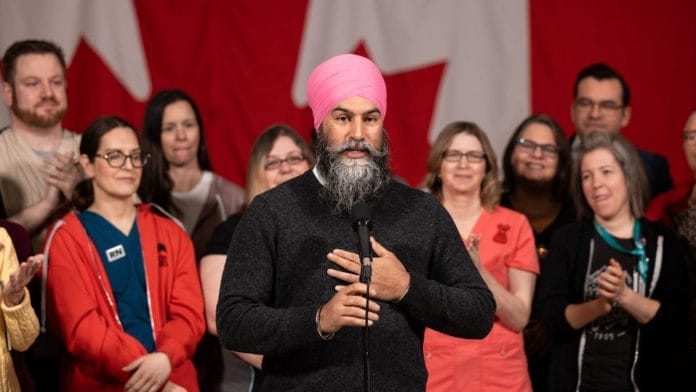New Delhi: Jagmeet Singh lost his seat in the Canadian Parliament and has resigned as party leader of the New Democratic Party (NDP), following the rout faced by the party in the federal election held Monday. The Liberal Party led by Mark Carney has won the elections.
Known for his support for Sikh separatism, Singh has led the third-largest party in the Canadian Parliament for almost 8 years. However, the NDP, which held 24 seats in the outgoing Parliament, is set to win around 7 seats in this election—a loss of 17 seats.
Singh has been a member of the Canadian House of Commons for 6 years representing Burnaby South. He won a by-election in 2019 to enter the Canadian Parliament. He is set to finish a distant third behind the Liberal Party candidate Wade Chang and Conservative Party candidate James Yan.
His riding—an electoral constituency in Canada—was redrawn for the 2025 poll, and renamed as Burnaby Central.
“I want to take a moment to congratulate Prime Minister Carney on his victory. He has an important job to do to represent all Canadians and to protect our country and its sovereignty from the threats of Donald Trump. Tonight and every night, all of us here, we’re on Team Canada,” said Singh during his election night address.
He added: “Tonight, I’ve informed our party leader that I’ll be stepping down as party leader as soon as an interim leader can be appointed. Now, I could not have done this incredible job without the incredible support my wife could have given.”
Singh’s resignation comes as the NDP saw their support crater following the resignation of Liberal Prime Minister Justin Trudeau in January this year. The NDP, which had a supply and confidence agreement with the Liberals between 2022 and 2024, broke its ties with the governing party in September last year. Singh at the time had announced his own candidacy for the top post in Canadian politics.
From neck-in-neck with Liberals to a distant fourth
By the time then Deputy Prime Minister Chrystia Freeland resigned from Trudeau’s government in December 2024, the NDP was running neck-in-neck with the Liberals in the opinion polls. The Liberals stood at roughly 21 percent in the opinion polls, while the NDP had risen to around 19 percent, according to 338Canada. The election in 2025 seemed poised for a Liberal wipeout akin to the 2011 federal election, which saw the NDP become the second-largest party in the House of Commons.
However, Trudeau’s resignation on 6 January, changed the fortunes of the party. By the end of January, the gap had grown to 7 percentage points between the NDP and the Liberals. By the time Canadians went to the polls Monday, the NDP support cratered, with the Liberals poised to win over 43 percent of the votes, while Singh’s party is set to win around 6 percent of the votes cast.
The party is likely to win around 7 seats, which is far less than the 24 it had in the outgoing House of Commons. The NDP faces further challenges going forward, given that a political party requires at least 12 seats in the House of Commons to receive “official party status” which gives it a raft of parliamentary privileges and funding.
The fall of the NDP comes as a result of the impact of US President Donald J. Trump in the Canadian polls. Trump, who has urged Canada to become the “51st state” of the US, a statement he reiterated as Canadians turned out to vote Monday, saw the Liberals under Carney gain the confidence of the electorate.
Trump has also unleashed a global trade war, which acutely impacts Canada, given that the US accounts for around 77 per cent of Ottawa’s total exports. Carney, the former Governor of the Bank of England, sought to leverage his experience as a central banker in dealing with Trump.
The gain of almost 11 percentage points by the Liberals in votes in the 2025 elections coincides roughly with the loss of about the same in terms of votes for the NDP.
(Edited by Zinnia Ray Chaudhuri)
Also read: From central banker in economic crises to steering Canada as PM amid challenges, who’s Mark Carney?






